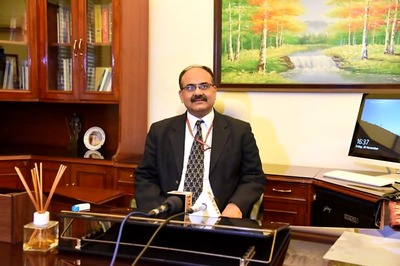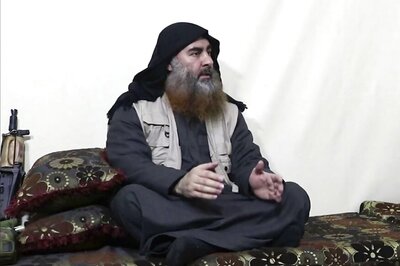
views
New DelhiThe entire spectrum of caste equations, unauthorised colonies and migrant population will remain in focus in the North East Delhi parliamentary constituency from where political heavyweights—three-time chief minister Sheila Dikshit, BJP leader Manoj Tiwari and AAP's Dilip Pandey—will try their luck on May 12.
The constituency has the highest concentration of Purvanchalis, Muslims and migrants from Uttar Pradesh and Bihar, who play a decisive role during elections.
According to the 2011 census, North East Delhi is the most populous district in the Capital. The population of the area has grown by 26 per cent since 2001. Today, it has the highest population density in Delhi—36,155 persons per square kilometre. A classic example of the population boom due to migrants, the constituency has thousands of migrants from Uttar Pradesh and Bihar.
The seat also has close to 22 per cent Muslim population, the highest across all Lok Sabha segments in Delhi. A majority of this population is concentrated in five assembly constituencies, including Ghonda, Seelampur, Mustafabad and Babarpur.
While the Congress is fielding Dikshit, who was the Delhi chief minister for 15 years till 2013, against BJP's Delhi chief Tiwari, Aam Aadmi Party's Dilip Pandey will be making debut in this election, thus making it a tri-polar contest.
Various surveys has pointed out that Congress’s core voters in North East Delhi were Muslims who now have shifted to the AAP. In 2015, the party won nine of the 10 assembly segments in this constituency, with many poll pundits and surveys claiming an en masse vote transfer of Muslim votes to AAP.
Purvanchalis, however, remain the largest chunk of the population in the constituency at 30 per cent. Tiwari, a Purvanchali himself, won the seat in 2014 Lok Sabha elections. Tiwari got 5,96,125 votes, defeating AAP's Anand Sharma who got 4,52,041 votes. This time, too, Tiwari is in the fray. Over the years, the community has gained a considerable political clout with all major contenders trying to woo them.
Apart from his own star power, Prime Minister Narendra Modi’s face and the “achievements of his government at the Centre”, form the core of BJP’s campaigns.
The seat also has a sizeable chunk of Dalits, Brahmins and Vaishyas in pockets of Yamuna Vihar, Dilshad Garden and Timarpur.
In the constituency, there are also some sections of people who appreciate the AAP government's efforts in the education and health sectors.
“AAP is a preferable alternative for us because it has worked well. It has lowered the electricity rate and water bills and I think statehood should be done,” said Dinesh Chabra, 37. Chabra, who lives in the eastern part of Shahahdra, doesn’t see any local leadership from the two national parties in Delhi.
“I think Modi is working but his subordinates are not working. Same is the case with Congress. Sheila Dixit did well in terms of starting the Delhi Metro and making good roads, but now we don’t see any leadership in the party,” Chabra added.
Dikshit had earlier successfully led the Congress in 1998, 2003 and 2008 assembly polls, but the party suffered a rout in the 2013 elections under her leadership. The Congress could not even open its account in the 2014 Lok Sabha polls and the 2015 assembly elections in Delhi.
Around 1,500 families form the Koli society in Shahadra. Their forefathers had come from Sindh, Pakistan during the partition and most of them are either labourers or scrap dealers. Staunch supporters of the BJP, most of the presidents here, however, don’t even know the name of the MP from their constituency. Yet, the love for BJP and PM Modi runs deep.
“Modi ji is saving the country. We will only vote for him,” said Santosh Devi, 45.
But in many parts of this constituency, development in unauthorised colonies, bad roads and poor quality of water are also some poll issues that will decide the voting patterns.
According to government statistics, close to 300 unauthorised colonies and 46 slum clusters across the assembly segments of Burari, Timarpur, Seemapuri, Rohtash Nagar, Seelampur, Ghonda, Babarpur, Gokulpur, Mustafabad and Karawal Nagar constitute the rural-urban, Poorvanchali-Muslim combination of the seat.
In Seelampur, AAP’s fortunes seem to fare better than BJP and Congress. Ali Daraz Khan, 85, who came from Farrukhabad, Uttar Pradesh, has voted in 12 Lok Sabha elections. His elder son died a few years ago due to illness. “Kejriwal is a good choice,” Khan said.
First-time voter, Qadri Khan, 20, echoes the same. “Since this government came, work has been affected severely. The GST and demonetisation were not good decisions and have affected our work,” Khan, a shopkeeper said.
With North East Delhi’s being one of the interesting fights in the capital, Congress is also trying to resurrect itself. Congress leader Priyanka Gandhi Vadra held a roadshow on May 8 in support of Sheila Dikshit, drawing a huge crowd.



















Comments
0 comment